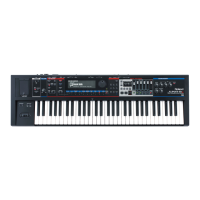57
Overview
Appendix
USB Memory
Song Player
Digital Recorder
Synthesizer
Selecting Sounds Perform. Functions Editing/Eects Other Settings
Rec/Play/Edit Eects Rhythm Pattern
24: FLANGER
This is a stereo anger. (The LFO has the same phase for left and right.)
It produces a metallic resonance that rises and falls like a jet airplane taking o or
landing. A lter is provided so that you can adjust the timbre of the anged sound.
R in
R out
L in
L out
Flanger
Feedback
Feedback
Flanger
Balance W
Balance W
2-Band
EQ
2-Band
EQ
Parameter Value Explanation
Filter Type
Type of lter
OFF No lter is used
LPF
Cuts the frequency range above
the Cuto Freq
HPF
Cuts the frequency range below
the Cuto Freq
Cuto Freq 200–8000 Hz
Center frequency when using the
lter to cut a specic frequency
range
Pre Delay 0.0–100 msec
Adjusts the delay time from
when the direct sound begins
until the anger sound is heard.
Rate # 0.05–10.00 Hz, note Frequency of modulation
Depth 0–127 Depth of modulation
Phase 0–180 deg Spatial spread of the sound
Feedback # -98–+98%
Adjusts the proportion of the
anger sound that is fed back
into the eect. Negative (-)
settings will invert the phase.
Low Gain -15–+15 dB Gain of the low range
High Gain -15–+15 dB Gain of the high range
Balance # D100:0W–D0:100W
Volume balance between the
direct sound (D) and the anger
sound (W)
Level 0–127 Output Level
25: STEP FLANGER
This is a anger in which the anger pitch changes in steps. The speed at which the
pitch changes can also be specied in terms of a note-value of a specied tempo.
R in
R out
L in
L out
Feedback
Feedback
Balance W
Balance W
2-Band
EQ
2-Band
EQ
Step Flanger
Step Flanger
Parameter Value Explanation
Filter Type
Type of lter
OFF No lter is used
LPF
Cuts the frequency range above
the Cuto Freq
HPF
Cuts the frequency range below
the Cuto Freq
Cuto Freq 200–8000 Hz
Center frequency when using the
lter to cut a specic frequency
range
Pre Delay 0.0–100 msec
Adjusts the delay time from
when the direct sound begins
until the anger sound is heard.
Rate # 0.05–10.00 Hz, note Frequency of modulation
Depth 0–127 Depth of modulation
Phase 0–180 deg Spatial spread of the sound
Feedback # -98–+98%
Adjusts the proportion of the
anger sound that is fed back
into the eect. Negative (-)
settings will invert the phase.
Step Rate # 0.10–20.00 Hz, note Rate (period) of pitch change
Low Gain -15–+15 dB Gain of the low range
High Gain -15–+15 dB Gain of the high range
Balance # D100:0W–D0:100W
Volume balance between the
direct sound (D) and the anger
sound (W)
Level 0–127 Output Level

